The Dance
The year began with swift optimism. Equity markets quickstepped higher, while credit spreads swung tighter. Buyers lined up to purchase new bonds from both investment grade and non-investment grade issuers. In sequence, investors who were knocked down by one of the worst years of their careers bounced back up and danced.
March Madness
Jump forward to March and the rush for the dancefloor shifted to a rush for the exits. On Wednesday, March 8th, following a steep drop in deposits, Silvergate Bank announced that it would wind down operations. At the same time, Silicon Valley Bank (SVB) was experiencing a bank run of its own. By Friday, SVB’s doors were shut. On Sunday, a third victim, Signature Bank, closed. The U.S. had entered a regional banking crisis.
The following week, the crisis of confidence extended to Europe. On March 19th, under the watchful eye of global regulators, UBS Group AG announced a takeover of troubled cross-town and global rival Credit Suisse.
Round of 32
The main culprit that shook the confidence of the banking sector stateside: losses on “risk-free” Treasury Bonds. As yields rose over the past year, bond prices dropped – meaning banks, who hold significant amounts of bonds on their balance sheets, were facing losses. When finance textbooks talk about the theoretical “risk-free rate”, they are typically referring to a 3-month Treasury Bill, not a 20+ year Treasury Bond.
The 1.875% coupon U.S. Treasury Bond maturing November 15, 2051, ended last quarter priced at “68-10”, to yield 3.7%. For those who don’t frequently trade Treasuries, we remind you that the pricing convention for Treasury Notes and Bonds is to quote each incremental “price tick” in “32nds” or 1/32 of one percent. Said alternatively, this bond’s price was 68-10/32, “68 and 10 ticks” or simply $68.31.
As we can see in the graph below, since being issued near par of $100 in November 2021, the bond has dropped over 30% in price! This long-bond pays an annual coupon of $1.875 for the next 30-years. Unfortunately, since newly issued long-bonds yield 3.7%, they pay a much higher annual coupon of $3.70. The 1.875% bond, with its low fixed coupons, is a lot less valuable.
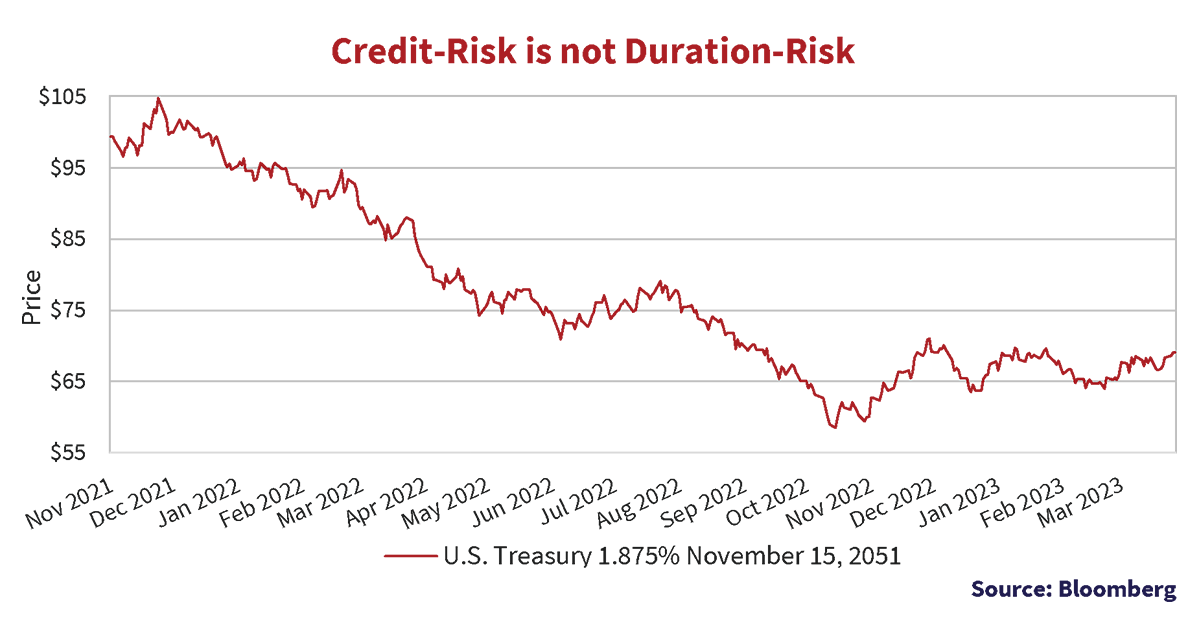
Sweet Sixteen
With $209 billion in assets at year-end 2022 (more than 3x the 2019 tally), Silicon Valley Bank was the 16th largest bank in the United States. Deposits stood at $191 billion, 88% of which were uninsured. Uniquely, SVB did not have a diversified retail deposit base. Rather, their depositor base consisted primarily of commercial and private banking clients with close ties to the venture capital world. To highlight the concentration, SVB’s top ten clients held $13.3 billion in deposits at the bank.
For SVB, a slow trickle of deposit withdrawals turned quickly into a flood once stakeholders lost confidence in the bank. One catalyst – those pesky long-dated bonds. As SVB quickly grew deposits, it needed to invest the new found cash. The bank decided to reach for yield, buying longer-dated bonds that provided marginally incremental income. This created a classic asset/liability mismatch. Deposits began to slowly bleed throughout 2022 as the froth came off the venture capital market. By the end of February 2023, SVB was forced to sell the longer-dated bonds to raise liquidity. Suddenly, the unrealized losses on their balance sheet became realized, threatening their capital position.
In an effort to shore up capital, the bank attempted to sell $2.25 billion of equity into the market. Instead of restoring confidence, this frightened investors. The equity sale was pulled and the stock dropped 60% the next day. On Thursday, March 9th, $42 billion of deposits, approximately 25% of the remaining total, left the bank. By the following morning, the bank was shut down by regulators.
Down to the Final Four
For the Federal Reserve, the Treasury Department, the Federal Deposit Insurance Corporation (FDIC) and the White House, it was time to act. Having learned (hopefully) that taxpayers are not keen on bailing out wealthy bankers, how would these four react to restore trust and confidence within the banking system?
First, the four parties determined that this was a “systemic risk” – opening up powers on how to deal with it. The “systemic risk” label allowed the FDIC to fully protect all depositors: insured and uninsured. So as not to be considered a “taxpayer bailout”, any losses to the Deposit Insurance Fund would need to be made whole by a special assessment to other banks. Furthermore, the rescue did not protect debtholders, shareholders or management. As we can see in the chart below of SVB’s senior unsecured and junior subordinated bonds, the quick action to protect depositors will likely result in a less than full recovery for the senior debt and a near complete wipeout for the juniors.
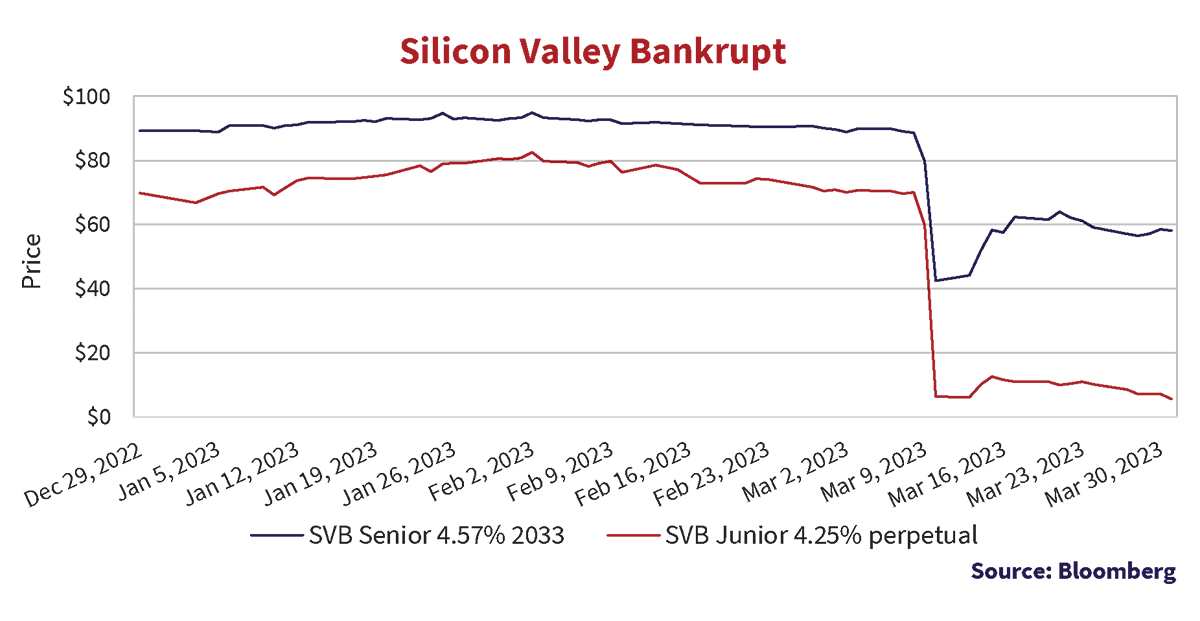
Second, recognizing the peskiness of the fallen “risk-free” securities, the Fed implemented the Bank Term Funding Program. This program allows banks to turn those below-par securities back into par securities in the event they need liquidity. Banks can post that 68-10 priced bond to the Fed’s Discount Window in return for a $100 cash loan.
National Champion
Across the Atlantic, fearing the failure of their second largest bank, Credit Suisse, Swiss regulators desperately knocked on the door of their largest bank, UBS. Having considered the alternatives: liquidation, nationalization, sale in parts, the regulators made it clear to UBS that a rushed sale was their focus. Firmly determining who held the leverage, negotiations began.
After years of turmoil, Credit Suisse ended 2022 with Swiss Franc (CHF) 531 billion in assets, CHF 35 billion in book equity and a CHF 11 billion market cap. By the end of the weekend negotiations, UBS had managed to purchase Credit Suisse for CHF 3 billion. In addition, Swiss regulators agreed to provide UBS a CHF 100 billion liquidity facility and share up to CHF 9 billion in potential losses. Not only that, but CHF 16 billion of Additional Tier 1 (AT1) securities at Credit Suisse would be written-off – a sum that would directly increase the book value of equity. Nice deal!
The graph below plots the credit spread of a 10-year Credit Suisse senior unsecured bond together with the credit spread of a 10-year UBS senior unsecured bond. As we can see, Credit Suisse’s risk premium went from slowly deteriorating to quickly distressed, as spreads moved wide of 800 basis points (bps). With the announcement of the UBS takeover together with government support, spreads promptly snapped back in.
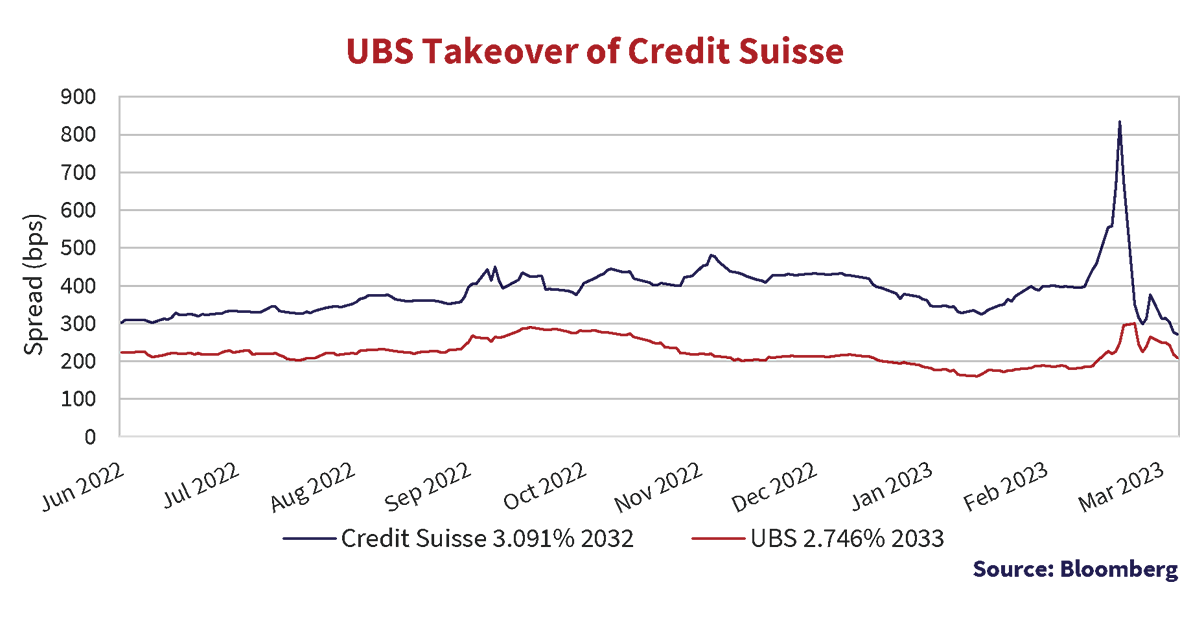
CoCo’s Puffed
Convertible Contingent “CoCo” bonds are a form of AT1 debt that theoretically sit above common equity and below subordinated debt in a bank’s capital structure hierarchy. But this technical speedbump didn’t stop the Swiss regulator, Finma, from writing them down to zero while maintaining value for the equity.
Finma’s statement on the matter:
“In close coordination with FINMA, the Swiss Confederation and the SNB, UBS will take over Credit Suisse in full. The extraordinary government support will trigger a complete write-down of the nominal value of all AT1 debt of Credit Suisse in the amount of around CHF 16 billion, and thus an increase in core capital.”
Source: “Finma Approves Merger of UBS and Credit Suisse.” Eidgenössische Finanzmarktaufsicht FINMA, 19 Mar. 2023
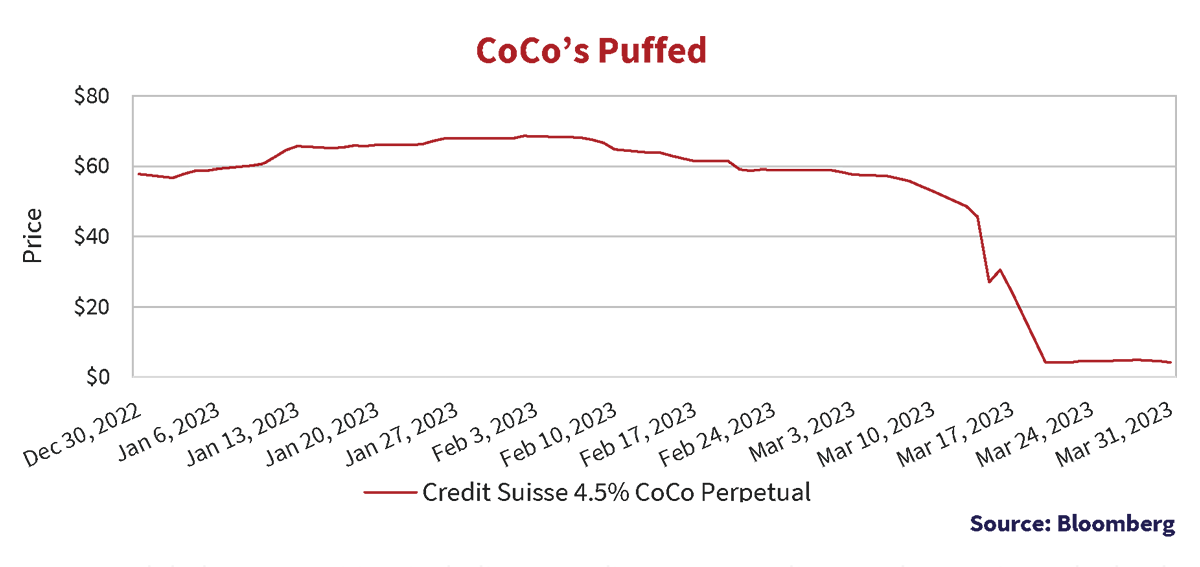
For most global AT1 securities, including Canadian LRCNs, a distressed scenario at the bank would include both the common equity and AT1 securities becoming significantly impaired. It is rare to see securities higher up the capital structure (AT1) being completely written-off without lower ranking securities (common equity) being completely written-off. But in Switzerland, the offering documents explicitly state that this scenario is possible.
The Bottom Line
The first quarter was a turbulent period, particularly for bond investors, who endured sharp moves in yields. When the dust settled, a renewed appetite for risk and lower bond yields ultimately prevailed over market volatility. The chart below outlines quarterly returns across major fixed income and equity indices. Equity markets overcame uncertainty in the bank sector and saw strong gains in the quarter, while the resurgence of tech stocks resulted in a notable outperformance for the Nasdaq. Fixed income markets were carried forward by the impact of falling government bond yields and resilient credit spreads outside of bank issuers.
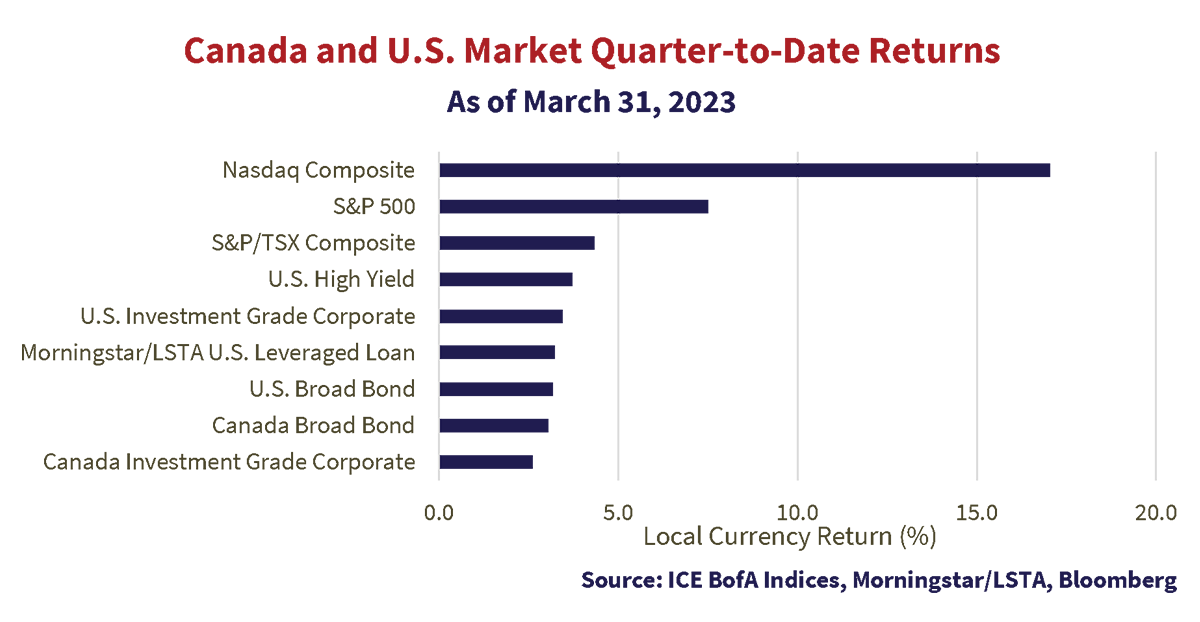
With or Without You
High quality bond markets in Canada and the U.S. both advanced in the quarter. The impact of government bond yields continues to be the primary driver of returns, as investors recalibrate their central bank expectations. The graphs below plot the 2-year yield of Government of Canada and U.S. Treasury bonds, where some of the fiercest swings were felt, relative to the overnight rate. In both cases, yields have now fallen below the central bank controlled administered rate, implying with increasing confidence that rate cuts are on the way.
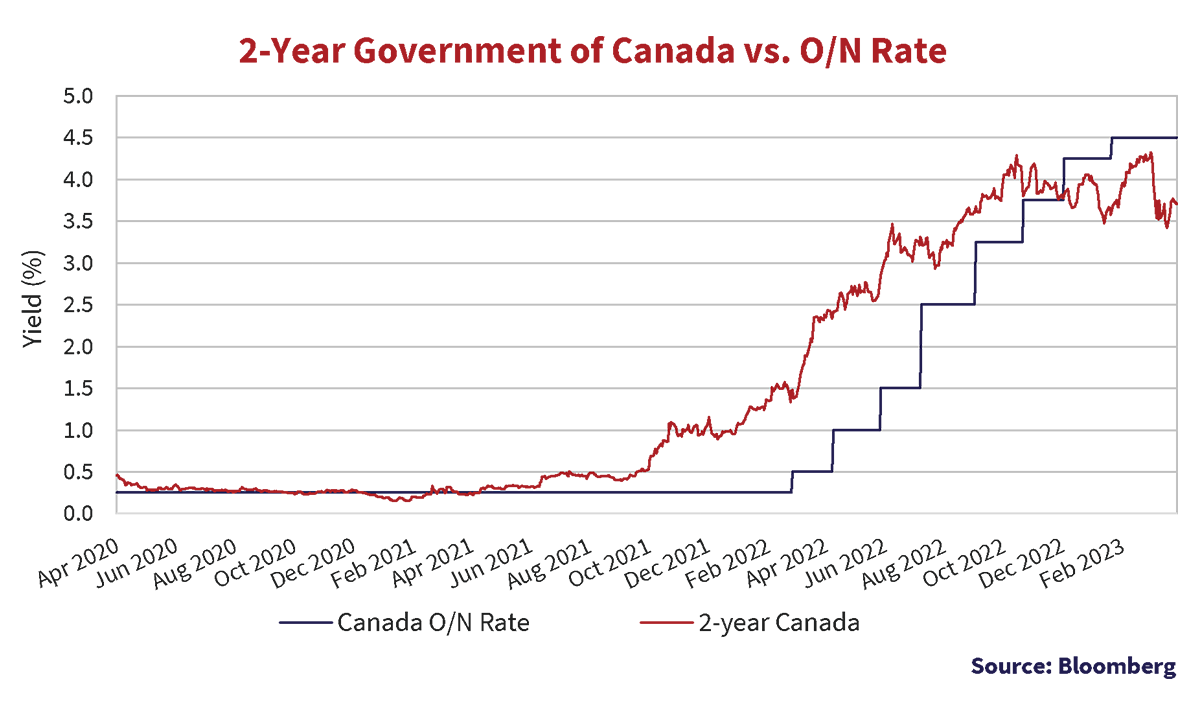
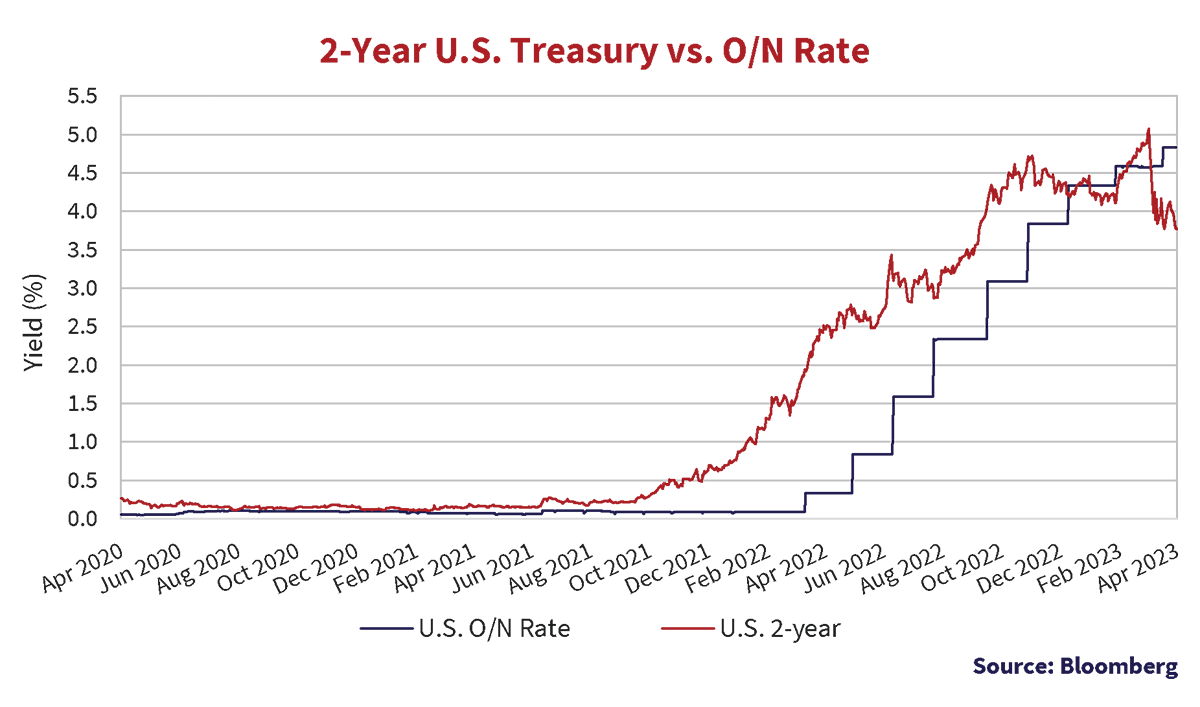
The graphs above also provide a useful perspective on how far interest rates have climbed off the bottom. Bond investors now have yield on their side to provide a buffer while the market attempts to guess when conditions will finally be right for the central banks to relent. With short term government bond yields above 4% it is not surprising that investors are rethinking their investment strategies and migrating in mass into money market funds.
Corporate Action
Investment grade risk premiums in Canada and the U.S. plotted a volatile path and in the wake of the banking crisis ultimately ended the period 8 and 7bps wider, respectively. This proved to be a light headwind against the price appreciation from falling government bond yields.
The graph below plots historical credit spreads in Canada and the U.S. based on the ICE BofA Indices. Through the first two months of the year, both markets experienced steady appreciation and absorbed significant new issuance. In Canada, spreads opened the quarter at 183bps and finished February at 163bps. The trend was similar in the U.S. but with the tightest spreads being realized earlier in February before strong employment numbers shifted sentiment towards a more aggressive Fed.
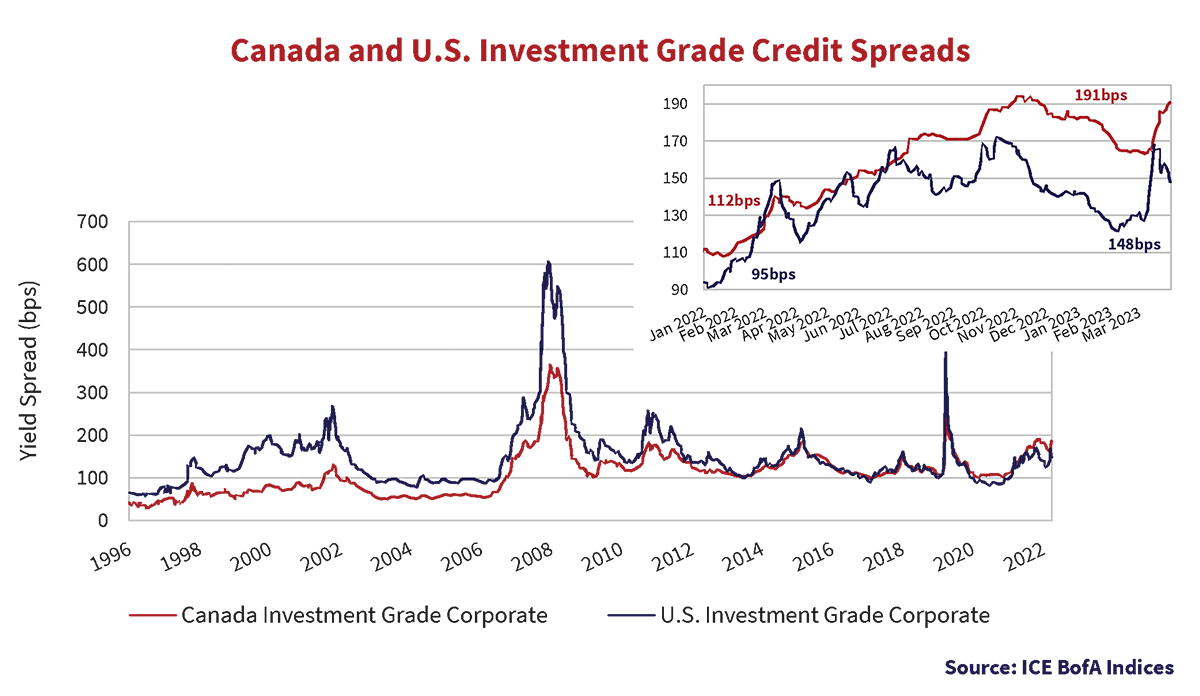
After the sharp increase in March, both markets ended up just above where they started the quarter. In both Canada and the U.S., exposures to bank issuers accounted for approximately half of the total spread widening in March. Bank issuers widened an average of 55bps in the U.S. and 38bps in Canada. However, the Canadian Corporate Index exposure to the banking sector is much higher at 32.5% relative to 18.2% in the U.S.
The Song Remains the Same
At the end of 2022, we observed that risk premiums for investment grade bonds were looking more and more compelling. This is particularly true in the Canadian market where credit spreads diverged from the U.S. last summer and now look like reasonable value at 191bps. Spreads were becoming compelling relative to the post-pandemic lows, but also relative to historical precedents. From the historical track record in the graph above, we can observe that Canadian investment grade spreads are now above the wide spreads of 2011 and 2016 and behind only 2008 and 2020.
Despite this, we continue to observe that a deterioration in credit fundamentals still doesn’t appear to be reflected in the pricing of Canadian investment grade bonds. We have once again plotted the difference between BBB and A rated credit spreads derived from FTSE Canada indices. The graph is materially unchanged and remains persistently below average and below prior cycle peaks. If lower governments bond yields are signaling recession, corporate valuations have not gotten the message, as investors are not being incrementally compensated for increased credit risk.
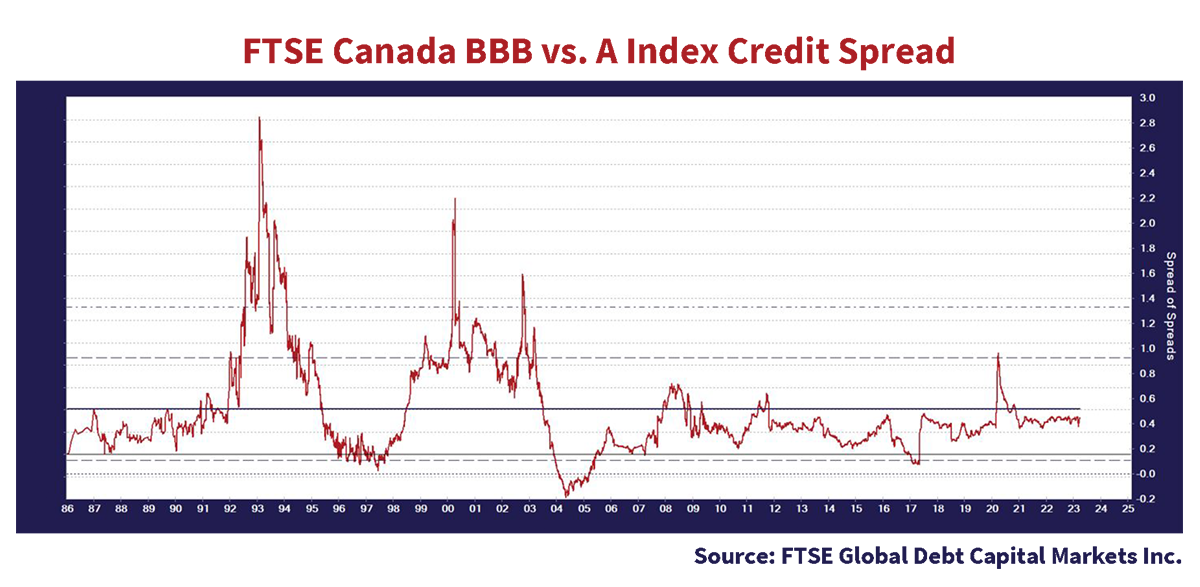
Under Pressure
On April 3rd, Rogers closed its $26 billion acquisition of Shaw, 2 years after announcing the deal. Within 3 days, DBRS, Fitch, Moody’s and S&P all downgraded Rogers debt from BBB+ to BBB-, only 1 notch above a high yield rating.
The combined Rogers/Shaw business will be acutely watched by these rating agencies over the coming years and there will be little room for missteps. Rogers’ leverage jumped to 5.3x following the close of the deal, up from 3.5x before the announcement. This compares to leverage that remains in the mid-3x’s at competitors BCE Inc (BBB+) and Telus Corp (BBB).
Down The Road
Risk premiums in the U.S. high yield market were also volatile in the first quarter, despite minimal banking sector exposure. The graph below plots the credit spreads of the ICE BofA U.S. High Yield Index. After pushing tighter through the first months of the quarter, spreads surged over 100bps wider in just a few days following the collapse of SVB only to rally back in as confidence began to be restored. At the end of the quarter, spreads ultimately tightened 17bps, which contributed to a strong 3.7% return in the period.
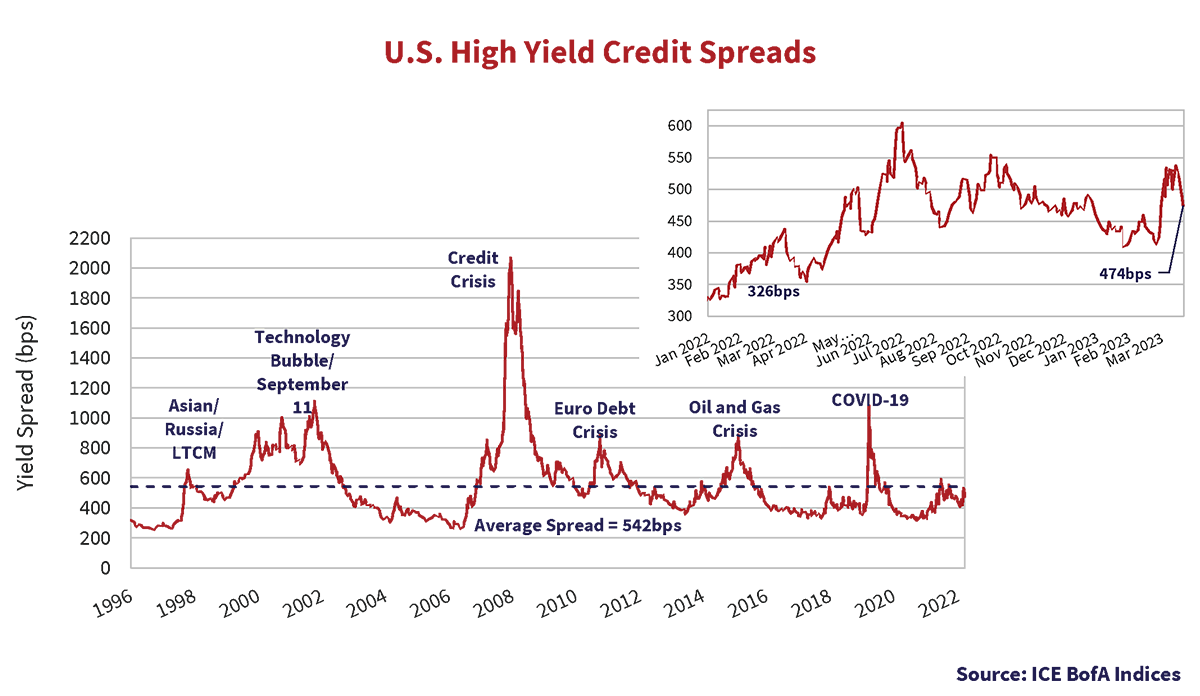
Hello, Goodbye
New issue activity in the U.S. high yield market found modest signs of life early in the quarter with gross volume of USD$20.6B in January and USD$14.4B in February, according to LCD. The average yield at issuance also declined to 8.5% in January and 7.8% in February, which issuers found attractive relative to new issue yields that had climbed above 10% at the end of last year. More favourable conditions also spurred an increase in refinancing activity during the quarter, which JP Morgan calculates at just over 70% of total issuance proceeds and a marked increase from 47% through all of 2022.
Once the market turmoil took hold in March, new issuance ground to a halt until the final days of the month when conditions began to improve. By the end of the quarter, total new issuance fell below the comparable total from 2022, a year which produced the lowest annual volume since 2008. The graph below of rolling high yield bond issuance from LCD continues to be a useful illustration of the magnitude of the fall from the peak in 2021.
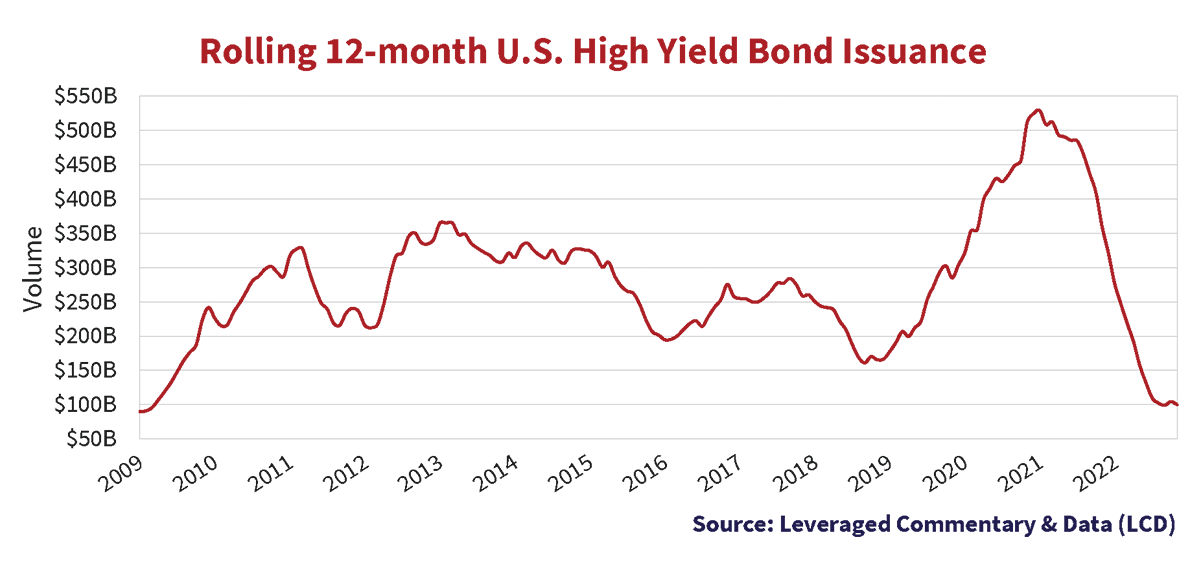
Just a Little Patience
The U.S. high yield bond and loan market began to see an uptick in default activity in the first part of 2023. In the first quarter, JP Morgan counts 12 companies defaulted totaling USD$18.4B split between bonds and loans and 5 more companies completed a distressed exchange impacting USD$2.2B. The combined total already accounts for 43% of last year’s full-year total and surpassed 2021’s 14 year low.
Despite this quarter’s increase, default rates remain modest and have not materially caught up with higher borrowing costs and tighter market conditions. The surge in defaults in 2020 combined with record new issuance in 2021 continues to be supportive. With risk premiums on high yield issues hovering around historic average, we continue to question whether investors are broadly paid for looming risks.
Game On
The recent playing of The Masters, and the serenity of its pristine scapes, brought a welcomed sense of calm and is perhaps a signal that Springtime hope and optimism has arrived. Toronto Maple Leafs fans will once again rally behind that sentiment as the team looks to recent additions to finally get them through yet another daunting first-round playoff match-up. The Super Mario Bros. Movie certainly delivered positive momentum with its record-setting box office debut that usurped Frozen II as the biggest opening weekend for an animated movie.
Bond markets are hoping (desperately) that Spring will deliver the conditions that will ultimately lead central banks to relent. As investors try to make sense of the volatile feelings of the bond market, and ever mixed messages across other asset classes, they can draw optimism from the fact that there is once again income in fixed-income. Yields on high quality and liquid bonds continue to be an attractive place to deploy capital while we wait for valuations on more speculative corporate issues to provide better compensation for their risks. Uncertain and increasingly illiquid markets invariably produce opportunity, and that is where our investment focus remains.